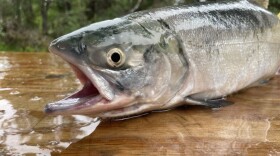It was a big spring for Alaska’s unofficial state bird.
Erin Lockwood certainly noticed more mosquitoes than usual at her house in Kenai. And she found it perplexing.
“I don't understand why we had so many mosquitoes this year," she said. "We lived here 47 years and we know when we have a dry spring, we don’t usually have a big plume of mosquitos. Yet we were slammed with mosquitos for a couple weeks.”
Those swarms have subsided since June. But Lockwood isn’t the only one who was more bothered by the mosquitos than usual this spring and summer.
Matt Bowser is an entomologist with the Kenai National Wildlife Refuge, meaning he studies insects.
The bad news, he said, is there’s no formal way to track mosquitos beyond mosquito magnets, which he said the refuge doesn’t use.
“All we have is anecdotal information," he said. "I've been here since 2001 or so. And it’s a bigger year, not the worst year I can recall. But we do know a little bit more about why. And so it was expected that it would be a big mosquito year.”
He said it has to do with the most common mosquito on the western Kenai Peninsula.
“Ochlerotatus communis. Doesn’t really have a common name," he said.
That type of mosquito lays eggs in dry areas in the woods that later fill with snow.
Their eggs sit and wait all winter, and in the spring, when the snow does melt, they hatch and breed in the cold water.
So when there’s more snow and snowmelt, like there has been the last two years, there are more places for those bugs to breed.
The good news, Bowser said, is the mosquitos don’t live that long. So they’re already starting to die out at this point in the summer.
"They should be slowing down," he said. "They’re still out, but you’ve probably noticed they’re getting to be fewer.”
One thing the unusually dry spring and summer could impact, however, is mosquito behavior, Bowser said.
Mosquitos don’t like the dry heat as much as they do cooler, wet weather. So even if they’re swarming in high numbers, they may not be quite as active during a hot spring and summer like this one.
Still, he said for Ochlerotatus communis — that popular mosquito variety — snowmelt is really what matters most.
Another bug that might have something to gain from the weather is the spruce bark beetles. Bowser said those beetles like hot, dry springs.
Their limiting factor is they need host trees. And with so many trees lost to the spruce bark beetle epidemic already, that might be a tall order.
You can find the original story here.






